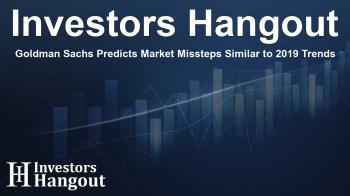Goldman Sachs Predicts Market Missteps Similar to 2019 Trends

Goldman Sachs Highlights Potential Market Errors of 2019
Goldman Sachs has recently conveyed a crucial message regarding market behavior, suggesting an ominous echo of past mistakes from 2019. Analysts from the prominent Wall Street bank have issued a statement emphasizing that impending decisions from the Federal Open Market Committee (FOMC) may not yield the substantial insights traders are hoping for.
Importance of the Upcoming FOMC Meeting
As the January FOMC meeting approaches, Goldman Sachs strategists express that the committee's forthcoming statement may acknowledge some stability in the labor market. However, it's unlikely to provide explicit guidance regarding the schedule for interest rate adjustments, particularly in light of the March meeting. This withholding of information could lead to challenges in market clarity.
Inflation Expectations and Rate Cuts
The strategists have indicated a keen interest in any signals regarding a continued decrease in inflation. They speculate that a downward shift in inflation levels might prompt the FOMC to consider rate cuts. Furthermore, they will be closely monitoring the leadership's perspective on the appropriateness of the current funds rate, which many still perceive as “meaningfully restrictive.”
Navigating Economic Uncertainty
Goldman Sachs is also set to explore insights surrounding the potential future of tariff hikes and their anticipated repercussions on pricing structures. The bank maintains a hopeful outlook towards 2025, forecasting a gradual approach to achieving the 2% inflation target. They anticipate modest recovery in labor market conditions which follow a projected softening phase in 2024, alongside GDP growth that exceeds traditional forecasts.
Impact of Tariffs on Inflation and Policy Decisions
In accordance with their analysis, Goldman Sachs predicts forthcoming inflation reports will indicate a continued year-on-year decline. They believe that given the economic landscape expected for the current year, the logic for rate cuts appears reasonable, even if not urgently necessary. However, the potential for tariff-induced inflation creates a complex dilemma for FOMC members, who may hesitate to implement rate cuts.
Lessons from Previous Monetary Policy Decisions
This analysis draws on historical data, particularly transcripts and analyses from Fed meetings during the 2018-2019 trade war, to reveal how the FOMC may react to current economic conditions. Interestingly, Goldman Sachs notes that Fed staff and members of the FOMC previously held a somewhat laissez-faire attitude toward the inflationary effects of tariffs, mirroring their present stance.
Forecast for 2024 and Beyond
The bank has outlined predictions for two potential rate cuts of 25 basis points each in June and December, with an additional reduction anticipated in 2026. These measures rest on expectations of continued inflation decline coupled with a resilient labor market. Nevertheless, Goldman Sachs cautions about the inherent unpredictability in the timing of these cuts due to prevailing economic forecasts and concerns regarding the FOMC's stance on tariffs.
Market Perceptions and Future Administration Policies
According to Goldman Sachs, market pricing seems excessively hawkish. Their analysts assert that the market-implied probability of interest rate hikes appears unreasonably elevated. They express doubt that new governmental policies will significantly elevate inflation, causing the FOMC to reassess its restrictive stance on rates.
The Echo of 2019's Lessons
In closing, the analysts express concern that the financial community might be overlooking critical lessons from 2019, a year marked by market turbulence due to tariff issues. They highlight how unexpected tariff negotiations led to the FOMC delivering “insurance cuts” to stave off economic disruptions. As industries adjust to a continually evolving financial landscape, such historical insights could play a vital role in shaping future decisions.
Frequently Asked Questions
What insights did Goldman Sachs provide regarding the upcoming FOMC meeting?
Goldman Sachs believes that the upcoming FOMC meeting will not provide substantial new insights but may recognize stabilization in the labor market.
What is Goldman Sachs' economic outlook for 2025?
Goldman Sachs expects a modest recovery in labor market conditions, with GDP growth surpassing consensus forecasts and a continued drop in inflation rates.
How does Goldman Sachs view the impact of tariffs on the economy?
The bank suggests tariff impacts may modestly increase inflation but emphasizes that FOMC decisions should consider potential room for rate cuts.
What rate cuts does Goldman Sachs anticipate in the coming years?
The firm forecasts two rate cuts of 25 basis points each in June and December, with an additional cut projected for 2026.
What historical insights did Goldman Sachs reference in their analysis?
Goldman Sachs reviewed transcripts and analyses from Fed meetings during the 2018-2019 trade war to understand the potential responses of the FOMC to current economic conditions.
About The Author
Contact Riley Hayes here.
About Investors Hangout
Investors Hangout is a leading online stock forum for financial discussion and learning, offering a wide range of free tools and resources. It draws in traders of all levels, who exchange market knowledge, investigate trading tactics, and keep an eye on industry developments in real time. Featuring financial articles, stock message boards, quotes, charts, company profiles, and live news updates. Through cooperative learning and a wealth of informational resources, it helps users from novices creating their first portfolios to experts honing their techniques. Join Investors Hangout today: https://investorshangout.com/
The content of this article is based on factual, publicly available information and does not represent legal, financial, or investment advice. Investors Hangout does not offer financial advice, and the author is not a licensed financial advisor. Consult a qualified advisor before making any financial or investment decisions based on this article. This article should not be considered advice to purchase, sell, or hold any securities or other investments. If any of the material provided here is inaccurate, please contact us for corrections.

